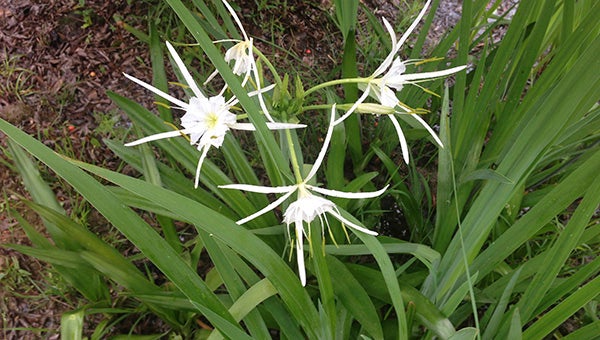Arboretum Paths: Summer: An excellent time for garden planning
Published 7:00 am Wednesday, July 15, 2015

This spider lily (Hymenocallis) growing near the Children’s Garden is a great example of a “plant it and forget it” type of perennial. (Photo by Pat Drackett).
In more northern climates, winter is the traditional time for planning garden or landscape, because this is a time when people tend to be much more comfortable in inside temperatures.
Winter garden planning also has a practical side. After all, yards are not as appealing or easy to work in with frozen soil or a blanket of a little-seen substance called snow. Fortunately, we don’t have to worry about ground being unworkable in winter. In the coastal South we have winter days that are warm enough to get outside and do some real gardening. Installing trees and shrubs during our dormant season, in late fall and winter long before we are enticed by spring blooms in the garden center, allows plant roots to enjoy a lengthy establishment period before hot weather returns.
How many plants have you installed in the spring months, only to catch a glimpse of withered leaves about this time of summer? Plan to begin digging new homes for your trees and shrubs, and installing them, on a brisk winter day!
Rather than spending time curled up in an armchair with a cup of hot cocoa looking over seed catalogs the way I picture gardeners in the frozen north spending their winters, keep your eyes peeled for plants that look their best in local gardens right now. Buttonbush, crinum lily, Hymenocallis, Texas star hibiscus, firebush, and Texas sage look pretty nice right now!
If a plant mystifies you, find out its identity by contacting your county Extension office, as they can usually make a quick ID from an emailed photo. Or take in a clipping to your local garden center.
Plan to spend some time at your (air-conditioned) library in the garden section and do some scheming and dreaming. Research books online for gardening in our coastal region and select a few to use as a foundation for your planning. Develop a game plan based on your needs and make plans to install some new plants in your garden this winter.
A little planning can really pay off when making winter your main season for installing new plants. Most garden centers need to make room for Christmas trees as winter approaches. You may discover last season’s trees and shrubs have been deeply discount in order to make room for holiday items.
What kind of projects would you like to undertake this winter? Perhaps you’d like to try some new fruit such as blueberries, mayhaw, mulberry, Chickasaw plum, or native persimmon. Or maybe you have a neighbor you would like to disappear. This situation may be remedied by planting an evergreen screen composed of plants such as southern wax myrtle, American holly, red star anise, Ocala anise, or American sweet olive.
You may be tired of mowing your lawn and would like to reduce the amount of property that you mow. Do you have trees or shrubs in your yard that are a pain to mow in around, perhaps a collection of impulse buys you have dragged home from the garden center and dotted throughout the property?
Consider creating a new island bed that will reduce your lawn area and to unify sections of unrelated plants. Choose a groundcover, perennial, or low spreading shrub that will visually unify the bed.
Island beds can be very simple to create. Why not start now? Pick a relatively cool morning to go outside with a hose and a can of contractor’s marking paint to create curvilinear bedlines for your new project area. It could be for one big blueberry bed, for example, using Southern highbush varieties bordered by dwarf varieties such as Vaccinium darrowii.
If you are feeling industrious, use layers of cardboard and wood chips, if you have a source, to smother weeds and eventually break down into a nice organic layer. In fall, you can gather bags of leaves when you see people laying them out by the side of the road, and in winter, plant into the decomposing mulch.
You can find information about this technique by researching the term ”lasagna gardening” on the Internet. Many books have been written about this lazy gardener’s method of creating new beds.
Come to the “All About Hummingbirds” program with James Bell on Saturday, July 25 from 10 to 11 a.m.James will reveal how you can fill your yard with hummingbirds. Learn what is going on in the hummingbird’s life, how they feed, why they fight so much, and simple tips and tricks to attract them. Program is suited to ages 8 and up. Members free, non-member adults $5, children $2. Please call 601-799-2311 to sign up.
The Arboretum is open Wednesdays through Sundays from 9 a.m. to 5 p.m. and located in Picayune, off I-59 Exit 4, at 370 Ridge Road (south of Walmart and adjacent to I-59). For more information about our programs and events, see the website at www.crosbyarboretum.msstate.edu.
FOR FURTHER EXPLORATION: The MSU Extension website at www.MSUcares.com has a wealth of specific information for Mississippi gardens. Enter a desired topic in the search engine on the home page, or browse the sections on landscaping and home gardening.
By Patricia Drackett





